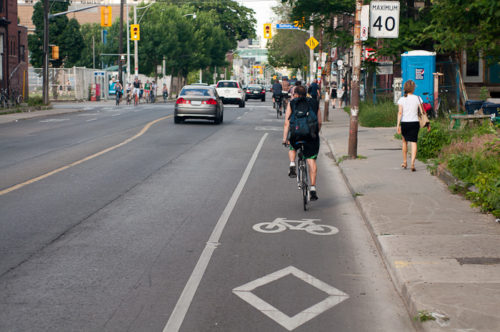Bike lanes on Bloor Street in Toronto may have been an idea in the works for some 40 years, but it looks like the pilot project could become a reality as early as this summer. In a report in The Globe and Mail, on March 8, 201, the pilot project – if approved – would call for a bike lane on one side of the street with a line of stationary cars between the cyclists and moving traffic. On the other side of Bloor, there would be a bike lane marked with flexible posts.
Cycling in urban areas has become a reality as more people are choosing to ride their bike to work, or use their bike as a source of income, such as delivering groceries, courier packages or restaurant takeout meals.
The Toronto Cycling Statistics are posed on the City of Toronto website at www.toronto.ca. As part of the national census, every five years Statistics Canada surveys Canadians on various subjects, including their “Journey to Work”. According to the Census, 1.7% of people in the City of Toronto rode their bicycle to work in 2006, while the number of people riding their bike to work in Toronto increased by 30% from 2001 to 2006. Source; Statistics Canada, 2008, www.toronto.ca.
While cycling in urban centres is a reality, so are cycling accidents. Cars still dominate the road and things like driving too close to cyclists and dooring (a driver opening their door without looking) present extra risk to cyclists. It is the responsibility of both drivers and cyclists to obey the rules of the road and to be aware of each other’s movements. In many cases, cyclists (and pedestrians for that matter) often do not have auto insurance. If you have been injured in an accident with a car, you may be eligible to receive certain benefits under Ontario’s no-fault insurance system as the Statutory Accident Benefits Schedule applies to drivers, cyclists and pedestrians. For cyclists without auto insurance, generally you would submit a claim for accident benefits through the driver’s insurance company.
Accidents involving cyclists can go beyond the no-fault benefit system and file a tort claim, but you would need to provide evidence of negligence by the driver, which could include actions like “dooring” or cutting off a pedestrian in a bike lane, and so on. Often this is difficult to prove. Bikes are considered to have vehicle status and therefore cyclists also have a duty under the Traffic Act to obey the rules of the road and not endanger the safety or property of fellow road users. Negligence by either vehicle drivers or cyclists can result in injuries including bone fractures and breaks, abrasions, internal injuries, catastrophic brain injuries and spinal cord injuries and paralysis. Regardless of who is at fault, if you have been hurt in a cycling accident with a motor vehicle, you are entitled to claim Accident Benefits from one the insurance companies covering the other vehicles involved. There are strict limitations on making claims, such as notifying the no-fault insurer within seven days of the accident and pursuing a tort claim within two years of the accident.
At Horowitz Injury Law we have nearly 35 years of experience in successfully dealing with bicycle accidents. If you have been injured in a cycling accident, call us today for a free legal consultation at 416-925-4100.




